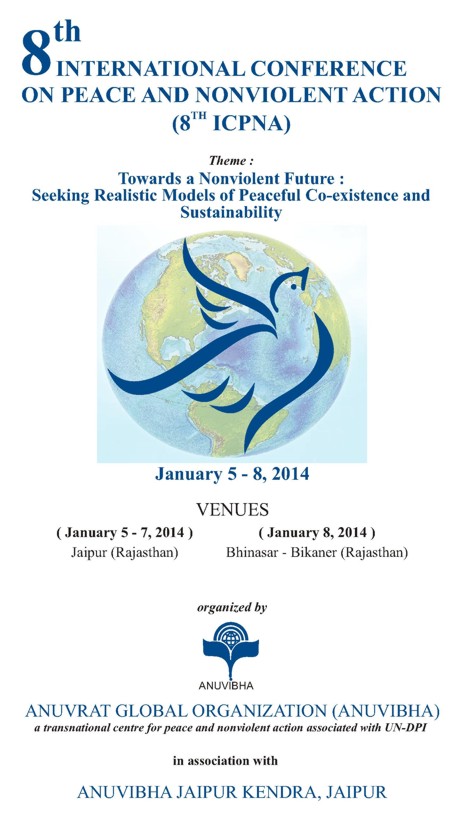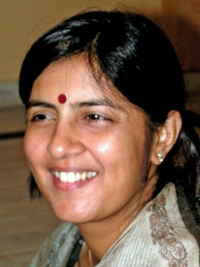 | 8th International Conference on Peace and Nonviolent Action |
A frequently cited verse from the Rig Veda is: ekam sat viprah bahudha vadanti, (1.64.46) translated as “Truth is one and the wise call it by many names.” Or, as for example Philip Goldberg states “One truth many paths.”(Goldberg, 2010). In a similar vein, it can be said that violence is complexly one, manifested in divergent ways, and there is no singular ideal approach to reduce violence.
Today there is a growing awareness of the broad spectrum of nonviolent ways for a futuristic peaceful world society. However, if we look back at the historical records, we find a myriad of nonviolent methods employed by world leaders - political, social, and religious; leading activists and civilians from diverse cultures and backgrounds. In any academic or public discussion on models of peaceful co-existence and sustainability we are indebted to mention a few cases of nonviolent action successfully implemented in the past, such as for example the three non-cooperation campaigns (1765-1775) of the American Revolution, or the nonviolent resistance and civil disobedience of Indian Independence (1930-1947). These are a few notable examples of nonviolent action for political change. Along these lines, many social movements emerged in different parts of the world, keeping nonviolence at its core.
The Anuvrat (‘Atom-vows’) Movement, which laid its foundation in 1949, is one such social-spiritual movements embracing Jain philosophy by embodying selective Jain principles that are secular in nature for a broader global appeal. The founder of the movement was the late Acharya Tulsi (1914-1997), a celebrated monk within the Jain Swetambara Terapantha tradition. According to Tulsi, one cannot solve the problems of violence, human rights, poverty and the environment all at once. Instead, he thought that by employing the concept of Anuvrat, i.e., small vows for the individual, borrowed from the Jain tradition, he could develop a framework for social improvement achieved through personal action. The Jain doctrines of ahimsa (non-violence), aparigraha (non-possession) and anekant (non-absolutism) served as the foundation for Tulsi’s Anuvrat program. Both non-violence and non-possession are pan-Indic concepts, however anekant is unique to Jain philosophy. Anekant is the theory that “truth and reality are perceived differently from diverse points of view, and that no single point of view is the complete truth” (Koller, 2004). Hence, Tulsi weaved the concept of anekant into the fabric of his mass movement.
In the Anuvrat model, Tulsi suggested a code of conduct comprising of 11 vows for establishing social justice, peace, harmony and sustainability that could be operated within the Indian subcontinent and across national boundaries. An identity of Anuvrati was given to one who accepted these Anuvrat vows. For the present paper, I will discuss first five out of eleven vows, which clearly belong to the category of Ahimsa.
Vow One: I will not intentionally kill any innocent creature. I will not commit suicide and I will not commit feticide.
Vow Two: I will not attack anybody. I will not support aggression. I will endeavor to bring about world peace and disarmament.
Vow Three: I will not take part in violent agitations or in any destructive activities.
Vow Four: I will believe in human unity. I will not discriminate on the basis of caste, color, religion, etc., and I will not treat anyone as an untouchable.
Vow Five: I will practice religious tolerance and not rouse sectarian frenzy.
The above-mentioned five vows exhibit deep reverence for life - the self, the human being, and the environment. The first vow especially singles out the issues of suicide and abortion, as Tulsi was aware that they were topics of great public debate in modern society at that time, above just issues related to animals.
In the second vow, Tulsi is acknowledging a widespread contemporary concern about combating the fears of terrorism and traumas of war inflicted upon humanity. Tulsi imagined that the Jain experience of the action of taking vows could possibly be beneficial to a secular society when combined with a willingness to be consciously aware of how actions, whether they are action of an individual or of a whole nation, could possibly affect other beings.
The third vow reflects another concern relevant to present time, i.e., violent agitations and destructive activities. On my inquiry, one Anuvrati responded: “The burning of police vehicles or buses on the road, breaking of tables and chairs in the college are a few examples of violent agitations. It is an outcome of extreme emotional disturbance. Tomorrow these same people will need buses to travel and chairs to sit on.” Hence, in her opinion, undertaking such a vow would at least deter an individual from voluntary involvement in destructive activities.
The fourth vow is not about physical violence, but is an extension of social violence. Tulsi poses a question as noted in the philosophy of the movement, “An evil thing may be untouchable, dirt or a contagious disease may be untouchable, but how can a man [or a woman] be untouchable?” It is a significant question for humanity to think about because how can there be a disparity of caste, creed, color or sex because of birth? Which theory purports such differences within humanity?
The fifth vow deals with the problem of religious intolerance. There are an increasing number of instances of violence stimulated by religious intolerance around the world leading to violence between different religious groups, as well as internal conflicts within religious groups. Even more importantly, accepting such a vow is also promoting a secular viewpoint.
In essence, these vows present Tulsi’s unwavering confidence in human potentiality for cultivating an atmosphere of peace. He believed that the seeds of violence sprouts in the mind and only the mind, although the implications are wide, on a global level even, and penetrate deep into the individual level. Therefore, any solution should imperatively begin from individual transformation. Like some speakers in the conference rightly said, if we free the individual from violence, then society will naturally be a nonviolent society.
Concerning nonviolence, Gene Sharp (1973), an expert in Nonviolent Action, describes the terminology of nonviolence in the following way:
“Nonviolence is the personal practice of being harmless to oneself and others under every condition. It comes from the belief that hurting people, animals or the environment is unnecessary to achieve an outcome and refers to a general philosophy of abstention from violence based on moral, religious or spiritual principles.”
Sharp’s description summarizes the first five Anuvrat vows formulated by Acharya Tulsi.
Even though Tulsi’s modified vows are marked by the theory of nonviolence, yet these vows do not really address the issues of domestic violence and non-vegetarianism. Domestic violence is a serious concern that demands attention and has taken various forms - physical, mental, emotional, psychological and economic. The laws regulating this issue vary by country. I would like to point out that a very small or insignificant fraction of the world population is moving from vegetarianism towards veganism, i.e., proscribing the use of dairy products. Therefore, any effort made towards a nonviolent society is futile in the presence of cruelty done towards animals for food habits. Like the German philosopher Immanuel Kant emphasized: “The means are important, as the end is important.”
Another topic that is discussed rigorously in this conference is whether religion is a boon or a curse. A new trend that is developing in the religious landscape is to call oneself ‘spiritual but not religious.’ This major shift could be attributed to disillusionment with established religion. Now, the challenge faced by nonviolent seekers is to explore the mighty power of spirituality before spirituality itself takes a reverse turn like religion did. Perhaps, Acharya Tulsi’s approach recognized this trend, therefore, he incorporated spirituality into a secular movement without direct reference to any specific religious ritual or institution. Can the term ‘anuvrat’ be used as synonymous to spiritual? Here, spirituality is understood in the way as yoga is understood independent of Hinduism or meditation is understood independent of Buddhism or any other specific religious system. Yoga and meditation are increasingly accepted as beneficial to holistic health. Similarly can Anuvrat independent of Jainism complete this trinity for a healthy society?
Although, this paragon of individual self-transformation through self-restraint is almost 65 years old, it still needs to be shared more explicitly with the world audience. During this conference, we have come to know that Dr. Thomas Daffern is seeking new models that could be implemented for a futuristic society: “I guess all of us gathered here can collectively make this dream into a REALITY”, he said: “My suggestion is to carefully analyze this model, which once upon a time achieved meteoric success. How can this model be revised to suit a postmodern world citizen desiring to create a peaceful global society?” [This is exactly what he did after the Conference, the result of which will be published in the Proceedings of the 8th ICPNA - Ed.]
References Cited
(Acharya), T., & (Association), J. V. B. (1985). Acharya Tulsi, Fifty Years of Selfless Dedication. Ladnun RJ, Jain Vishva Bharati.
Acharya Tulsi, & Acharya Mahapragya. (2000). Ahimsa and Anuvrat:Theory and Practice (Fourth.). Ladnun: Jain Vishva Bharati Institute.
Goldberg, P. (2010). American Veda: From Emerson and the Beatles to Yoga and Meditation How Indian Spirituality Changed the West (1st ed.). Harmony.
John M. Koller, “Why is Anekantvada Important?” in Ahimsa, Anekanta and Jainism, ed. Tara Sethia, (Delhi: Motilal Banarsidass, 2004), 85–98.
Lal, B. K. (2010). Contemporary Indian philosophy. Motilal Banarsidass Publ.
Sharp, G. (1973). The Politics of Nonviolent Action. Boston: P. Sargent Publisher.
Sheffer, G. (2006). Diaspora Politics: At Home Abroad. New York: Cambridge University Press.
Sugg, J. G. (2007). Dependence of the “Yoga Sutras” on the “Samkhya Karikas” (Ph.D., Humanistic & Transpersonal Psychology). Saybrook Graduate School and Research Center, California, U.S.
 Shivani Bothra
Shivani Bothra